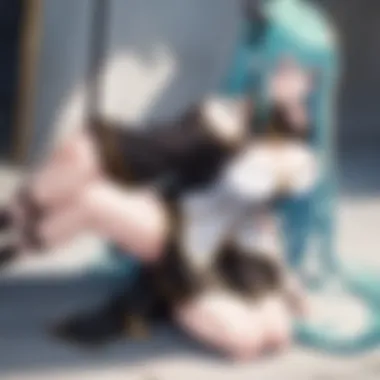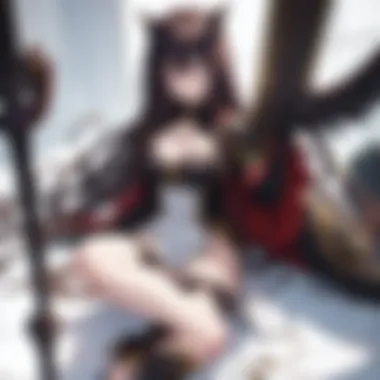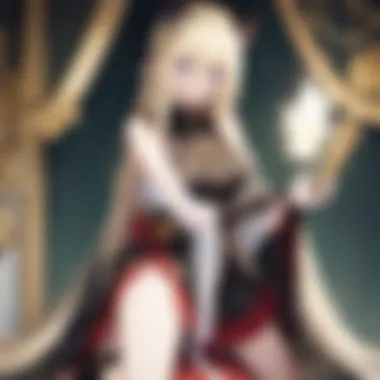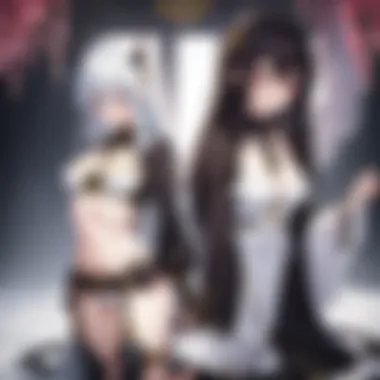How Not to Summon a Demon Lord: An In-Depth Study


Intro
This article undertakes an in-depth dissection of the anime How Not to Summon a Demon Lord. Recognized within fan circles as an intriguing entry in the isekai genre, the series draws viewers in with its mix of action, comedy, and fantasy elements. Through careful analysis, we aim to explore the series' intricate themes, dynamic characters, and narrative structure, offering insights that benefit both casual viewers and dedicated fans alike.
Our examination will highlight distinct episodes, analyze character development, and compare the anime adaptation to its corresponding manga. This comprehensive approach allows us to contextualize the series' impact on the isekai genre as a whole, considering the strengths and shortcomings that contribute to its overall reception.
Ultimately, this analysis seeks to engage anime enthusiasts by providing rich detail and significant arguments, fostering a deeper understanding of How Not to Summon a Demon Lord and its place within the vast tapestry of anime storytelling.
Episode Reviews
Summary of Each Episode
Each episode of How Not to Summon a Demon Lord propels the story forward with a blend of humor, action, and character exploration. The series follows Takuma Sakamoto, a socially awkward gamer, who suddenly finds himself transported into a fantasy world where he is mistaken for his in-game persona, the mighty demon lord Diablo. The narrative progresses through several interactions with various characters, including the female leads Shera and Rem.
Analysis of Key Events
- In the first episode, we witness the transition from the real world to the fantasy realm. This pivotal moment sets the stage for the characters' motivations and the clashes to come.
- As episodes unfold, the encounters between Takuma and characters like the Hero and Demon King's associates reveal multifaceted relationships, building upon the comedy and absurdity central to the series.
Discussion on Character Development
Takuma's evolution is a central focus. Initially perceived as an isolated individual, the reveal of his latent depth and desires comes as the series progresses. The growth of supporting characters, notably Rem and Shera, also enhances the narrative, intertwining their backstories with the main conflict.
Highlight Memorable Moments
Unquestionably, various scenes become memorable for the audience. Humor is often exploited in unexpected scenarios, particularly where Takuma adopts traits of his in-game persona. These light-hearted sequences serve a dual purpose, enhancing character development while prompting laughs.
Character Spotlights
Background Information on Characters
While Takuma serves as the principal focus, other characters each bring unique attributes to the tapestry of the series. Shera, the Elf, and Rem, the Demon, not only complement Takuma but also pursue their distinct arcs that enrich viewer engagement.
Personality Traites and Unique Quirks
- Takuma embodies a mix of overconfidence yet awkward responses to situations, serving as a source of comic relief.
- Shera's cheerful disposition contrasts with Rem's no-nonsense demeanor, projecting the varying reactions of individuals drawn into unusual circumstances.
Role in the Storyline
Each character plays a critical part in furthering the plot while challenging Takuma’s beliefs and viewpoints. They inherently become catalysts for change within the series narrative. Experimentations with their backstories intertwine their personal journeys with broader plot elements.
Fan Theories and Speculations
Speculation around character growth often fuels fan discussions. Many theories existing about Takuma's innate power hint at further developments. Discussions spike about how the resolution of his supernatural circumstances may lead to surprising turns.
Anime vs.
Manga Comparison
Plot Differences
Notably, discrepancies between the narrative arcs of the anime and manga exist. Several plot points receive divergent treatments, impacting pacing and character growth in contrasting ways.
Art and Animation Quality
Animation quality is generally commendable, lending itself well to the themes of the story. Nonetheless, manga panels exhibit distinct artistry that can often cater to drawing nuance, revealing in-depth expressions of characters.
Character Portrayal
Gradual narration within the manga tends to enhance a character's evolution more intricately, often bypassed in rapid episode presentation.
Fan Preferences and Opinions


Overall, fans display mixed preferences depending upon their engagement level within the series, indicating widespread debates over the shifts between adaptations.
Industry News and Updates
Announcements on Upcoming Releases
As of 2023, How Not to Summon a Demon Lord continues to resonate. New seasons from the anime have been highly anticipated, especially among avid goers who appreciate its thematic layers. Production news often emerges, spurring discussions across forums.
Analysis of Industry Trends
Not translating directly to increasing numbers in popularity, trends in advanced isekai fare shape public taste. Shows continually emerge in this space, showcasing varied stories. Industry dynamics foster both innovation and necessity for adaptations to capture audience engagement.
Insight into Production Process
Understanding the production intricacies transcends the general consumption of the anime. Involvement of experienced personnel contributes to the visual style adopted, optimizing appeal. Interviews with animators rarely reveal everything, yet hints towards challenges represent more broadly the art's demanding formation.
Top Lists
Ranking of Favorite Characters or Episodes
- Takuma Sakamoto
- Rem
- Shera
Engagement peaks when ranking moments that resonate emotionally or humorously with fans.
Compilation of Best Fight Scenes
Early combats, particularly across dungeon encounters fascinate viewers, advancing the stakes considerably.
Audience Polls and Feedback
Engagement metrics, largely across Reddit and similar platforms gauge viewer benchmarks following expansions to the lore.
Prelims to the Isekai Genre
The isekai genre has carved a niche in the realm of anime and manga. Understanding its elements is vital for anyone diving into series like How Not to Summon a Demon Lord. This genre typically involves characters who are transported to, reborn, or trapped in a fantastical world. The core themes such as escape from reality, adventure, and personal growth resonate with a broad audience. As evident in this series, the way it relates to personal identity offers depth to its narrative.
Definition and Characteristics
Isekai literally translates to
Overview of How Not to Summon a Demon Lord
Importance of Overview of How Not to Summon a Demon Lord
The overview of 'How Not to Summon a Demon Lord' is essential for understanding the broader context of the series within the isekai genre. This section helps readers grasp the foundational elements of the plot and character intricacies that make this series stand out. Different from other isekai stories, it mixes humor with serious themes, showcasing fantasy elements that resonate with a contemporary audience. An in-depth analysis can uncover audience perceptions and expectations, thus explaining why it attracts a substantial following.
Plot Summary
The plot centers around Takuma Sakamoto, a social recluse who is notorious for wielding extraordinary power in a game. Upon transferring into a fantasy world as his game character, the all-powerful Demon Lord Diablo, he unintentionally is summoned by two girls, Rem and Shera. As the narrative progresses, it becomes evident that Diablo must navigate complex relationships and challenges, often marked by misunderstandings stemming from his gamer perspective. The storyline adeptly addresses issues of identity, societal expectations, and emotional development, which are vital for viewers seeking deeper meanings beyond the comedy.
Main Characters
Diablo
Diablo is uniquely constructed as a demon lord in both appearance and abilities. His character often oscillates between extremes, from ice-cold aloofness to awkward honesty. This contrast makes him relatable to many viewers who have struggled with social anxiety or a lack of communication skills. Diablo's misadventures lead to critical growth and self-discovery. His reliance on game mechanics also highlights the disparities between virtual interactions and real-life emotions, making it a timely reflection of contemporary social dynamics.
Rem
Rem, as a demon maid, adds layers to the story. Her loyalty and fierce dedication provide depth to cosmic and trivial conflicts alike. Rem serves as both a character who supports Diablo hidden behind a facade but also challenges his decisions in essential episodes. This character's internal struggles reflect typical themes of sacrifice and resilience, allowing audiences to connect emotionally to her dilemmas through her role as a caretaker.
Shera


Shera introduces another dimension to the narrative. Her playful nature and carefree attitude make her essential in brightening otherwise dark themes. Despite her bubbly demeanor, Shera grapples with her insecurities and overall purpose. This conflict enables her to evolve throughout the series. For viewers, Shera's vibrant personality contrasts with Diablo's seriousness, enriching their collective narrative appeal and accentuating personal growth elements within the series.
Engaging with 'How Not to Summon a Demon Lord' proves to be more than mere entertainment; it invites viewers to explore significant exchanges between fantasy and reality.
This mosaic of characters ultimately creates an intricate tapestry that highlights not just personal growth, but also the dynamics of modern relationships in complex societies. Each character plays an indispensable role by catalyzing Diablo's personal development while tackling themes of loyalty, friendship, and self-worth.
Themes and Motifs
In How Not to Summon a Demon Lord, themes and motifs play a vital role in shaping the narrative and enhancing character interactions. They serve as essential tools for exploring deeper meanings behind the characters' choices and the situations they face. This section can help viewers understand the essential ideas at play, resulting in a richer viewing experience. Understanding these themes allows fans to appreciate the subtleties of the story and provides insights into character motives and behaviors.
Identity and Self-Discovery
The theme of identity permeates the series, especially through the character of Diablo. Initially, he exists as a recluse retaining his online gaming persona. His struggle involves reconciling his identity as the formidable demon lord within the game with his real-world vulnerabilities. This leads to moments of self-discovery as he interacts with the world, questioning who he really is. The transitions he undergoes illustrate the complexity of identity, especially for those who find it easier to escape into virtual realms, mirroring the experiences of many fans today.
Power Dynamics
Power dynamics are evident throughout the series and often manifest in character relationships. Diablo, as an ultimately powerful being, experiences frequent clashes with both friends and foes regarding control and authority. The characters of Rem and Shera offer a contrast, showcasing vulnerability yet holding influence in their own rights. Their interactions highlight how power can fluctuate based on the circumstances of their environment. Ultimately, this commentary on power prompts viewers to question their perceptions of strength and influence within personal relationships.
Relationships and Interpersonal Dynamics
Relationships form the backbone of the narrative, driving character development and plot progression. Diablo's interactions with Rem and Shera display the complexity of forming bonds in front of various backgrounds. His growing affection for both women reveals insights into vulnerability and connection. As they work together to navigate challenges, bonds are sometimes tested, yet they also grow stronger. This theme emphasizes the importance of communication, trust, and mutual respect in relationships, spilling over into the viewer's perceptions of the characters despite their fantastical origins.
The blend of personal growth and relationship tension encapsulats the essence of human experience, connecting audiences across different realities.
Through these themes and motifs, How Not to Summon a Demon Lord offers viewers a rich text to analyze. Characters become vessels through which stories of self-discovery, power struggles, and relationships unfold, guiding the audiences thoughtfully as they reflect on the wider context of the series.
Character Development
Character development serves as a cornerstone of storytelling in How Not to Summon a Demon Lord. This narrative element is essential as it cultivates a deeper connection between characters and viewers. It exposes motivations, flaws, and growth arcs, using them as a medium to illustrate broader themes.
Engaging character development invites audiences to invest emotionally in the story. When characters undergo transformation, whether drastically or subtly, it not only enhances the narrative but also reflects evolving human experiences. In this series, this evolution is particularly evident in the three central characters: Diablo, Rem, and Shera.
Diablo's Evolution
Diablo is a unique character, fundamentally shaped by his online gaming experience and isolation. Initially portrayed as the omnipotent Demon Lord, his journey transcends mere battles for dominance. One notable aspect of his evolution is his struggle with self-identity. He questions whether he is truly Diablo, the character he embodies within the game, or rather a reflection of a socially awkward person from the real world. This inner conflict manifests itself as a critical dimension of the narrative.
As the story progresses, the contrast between his demeanor as a feared demon and his true feelings of insecurity becomes striking. Accordingly, viewers witness Diablo's growth into a character capable of forming authentic connections. His developing relationships aimed at protecting Rem and Shera contribute significantly to his converting attitude.
While the external confrontation forms part of Diablo's journey, the internal battle regarding acceptance and recognition heightens drama. This complex portrayal sheds light on broader issues of identity that resonate with viewers, giving stakeholders moments of relatability in a fantastical context.
The Role of Rem and Shera
Rem and Shera represent crucial components in Diablo's character development. Their perceptions and relationships help to navigate Diablo's path toward understanding himself. Rem, in particular, offers a strong emotional anchor. She influences his moral decisions and compels him to face his past; for instance, her unwavering kindness gradually erodes his protective armor.
Meanwhile, Shera's cheerful nature complements Rem's more serious persona. Her dynamic brings an exuberant balance that accentuates interaction. Therefore, these influences foster a genuine emotional fabric essential to the series. Through the lens of Rem and Shera, viewers observe how Diablo begins to forge meaningful relationships with those around him.
Art and Animation Quality
The art and animation quality is a determining factor in how well a series resonates with its audience. For an anime like How Not to Summon a Demon Lord, these elements enhance the overall narrative and viewer experience in several ways. A series can build tension, showcase vibrant characters, and evoke emotions through carefully crafted visuals.
Visual Style
The visual style of How Not to Summon a Demon Lord significantly shapes the viewer's perception. The character designs reflect individual personalities and traits effectively. Diablo, with his imposing look contrasted by his awkward social interactions, is depicted with meticulous attention to detail. The colors used are often vibrant, which captures the essence of the fantasy world while also conveying mood.
The landscapes and settings contribute to the feeling of immersion within the isekai genre. The character movements and their realism play a huge role in how the story unfolds. Skillful use of lighting adds depth to various scenes, and varying backgrounds participate in developing an aesthetic that pleases fans and keeps them invested. Colors often shift in accordance to the emotional terms represented in the narrative, making viewer participation engaging.
Animation Techniques
When it comes to animation techniques, How Not to Summon a Demon Lord practices commendable methods to create fluid motion. The fights scenes demonstrate a blend of choreography and skillful animation. Every battle, powered by magic and physical combat, has its distinctive feel due to unique techniques used during animation. The clarity of actions paired with crisp graphics ensures that viewers follow the complexities of these encounters without confusion.
Moreover, effects during magic spells show intricate detail that enriches the spectacle. The mastery or incompetence portrayed by Diablo becomes obvious when animated alongside accompanying visual effects. Sourcing talent from experienced animators who understand the language of both narrative and audience expectation is crucial. Overall, these animation techniques manifest the studio's dedication to quality and storytelling.


Understanding these art and animation choices reveals a layer of depth that goes beyond surface aesthetics, providing insights into the care and thought put behind each frame of animation.
Critical Reception
The critical reception of an anime series is a crucial determinant of its long-term success and cultural relevance. Focusing on viewer reactions and critiques from reputed sources can unearth the sentiments accompanying How Not to Summon a Demon Lord. Understanding how it is received by audiences can inform on what resonates with viewers, whereas critiques help in analyzing the series' strengths and potential weaknesses. This section seeks to encapsulate the dual perspectives navigating the show’s journey, setting a foundation for future assessments.
Viewer Reactions
Audience reactions to How Not to Summon a Demon Lord play a significant role in the overall impact of the series. Social media platforms and forums like Reddit serve as vital spaces where fans express opinions, form communities, and engage in discourse. Many viewers praised Diablo's character as both relatable and humorous, contributing to a favorable reception. However, some parts drew mixed reviews regarding its portrayal of female characters and utilization of common tropes in the genre.
Viewer sentiments often align with both commitment and criticism:
- Deeper Engagement: Many find themselves deeply engaged with the character dynamics, creating emotional connections that enhance their viewing experience.
- Concerns About Representation: On the contrary, criticisms about the emphasis on comedic and fanservice elements flowers questions about representation and relevance to character arcs.
This mixture of praise and critique highlights the dynamic nature of viewer interpretation, suggesting ongoing conversations around the themes and executions in progress.
Critics' Reviews
Critics typically evaluate How Not to Summon a Demon Lord on various elements, such as storytelling, animation quality, and character dynamics. Renowned sources have voiced diverse opinions, creating a mosaic of feedback that supports deeper evaluation of the series.
Some critical points raised include:
- Narrative Handling: A prevalent constructive critique is the narrative progression, considered predictable by certain reviewers. They pointed out predictable plot points but acknowledged that an adept incorporation of humor helped keep it engaging.
- Character Depth: Critics provided accolades for character development, emphasizing Diablo’s evolving relationships and growth throughout the series.
- Visual Appeal: Observations around animation quality, often deservingly commended, noted excellence in artistry merging both the aesthetic and fluidity during action scenes.
The certainties laid by critics determine not just viewer preferences but guide future trends within the Isekai genre, impacting creation and perceptions of new releases.
Strong critical feedback cements the understanding of audience narratives, prompting future adaptations to reconsider plot management and character portrayal.
Cultural Impact
The series 'How Not to Summon a Demon Lord' presents notable cultural implications in the expansive realm of anime and manga. Its reception shifted perspectives on the isekai genre. This blend of humor, fantasy, and self-discovery resonates with a growing audience seeking both escapism and relatable narratives. The series has established itself, imprinting characteristics that others in the genre now recognize. Examining its influence offers insights into how it mirrors and shapes societal narratives.
Influence on the Genre
One can argue that the influence of 'How Not to Summon a Demon Lord' extends well beyond superficial entertainment. As the isekai genre continues to develop, this series serves as a template for blending the slice-of-life elements with fantasy conventions. Many newer titles mirror its narrative structure, where characters do not merely aim to survive but navigate complex social dynamics.
- Character Complexity: The protagonist's dual identity amplifies discussions on self-concept, which many may find relatable in their own lives.
- Peer Interaction: Relationships evolve from mere companionship to struggles against time and circumstance, creating engaging plots.
- Age Range Appeal: Unlike traditional entries aimed at younger audiences, this series attracts a sensible adult demographic, broadening the reach and depth of the genre.
The complexities of 'How Not to Summon a Demon Lord' thus lay groundwork for new expectations. These expectations extend not just to plot progression, but also to character growth that was minimally explored in prior titles.
The success of the series validated deeper character studies within fantasy realms, shifting narrative styles in isekai.
Merchandising and Spin-offs
Inconsidered analysis of any popular anime should recognize the thriving economic sector that surrounds it. 'How Not to Summon a Demon Lord' developed a multifaceted merchandising ecosystem. Product offerings have expanded as the series gained traction.
- Figures and Models: High-quality figurines detailing aesthetics pay notable tribute to character designs.
- Novel Adaptations: Spin-off light novels, such as those featuring Diablo and his adventures, help enrich the existing narrative tapestry.
- Video Games: The title has been transformed into engaging video games, allowing fans to dive deeper into the storyline while experiencing the fantasy world firsthand.
Ultimately, the commercialization observed shows a successful interconnection of creativity and business, further entrenching this series into popular culture while highlighting its buoyancy in the market's evolution. Outstanding merchandise combined with compelling storytelling illustrates enduring cultural significance.
Closure
The conclusion of the article serves a vital role in drawing together the various threads of analysis regarding the series. It reinforces the significance of the ideas presented and reflects on the diverse aspects explored throughout the piece. Within the body of a deep examination, highlight the importance of patterns in storytelling, character interrelations, and the significance of thematic elements. Each of these points contributes not only to an appreciation of How Not to Summon a Demon Lord but also to a broader understanding of the isekai genre as a whole.
Summation of Key Points
In reviewing the series, it is necessary to emphasize several crucial aspects:
- The integration of fantasy elements paired with relatable character arcs enhances viewer engagement.
- The complexity of Diablo's character demonstrates the blend of comedic moments with serious undertones, reflecting real-world issues like identity and power.
- The series' status as an influential piece within the isekai genre underscores its impact on subsequent works.
Overall, the narrative structure not only entertains but also prompts viewers to reflect on deeper societal themes, making it a noteworthy entry in modern anime.
Future Prospects of the Series
As of now, there are indications that How Not to Summon a Demon Lord may continue to expand. Fans express optimism for a potential third season and more related content. The established popularity suggests there is room for further character development and exploration of existing themes. Moreover, spin-offs and merchandising options present significant opportunities to extend engagement with the franchise.
As the isekai genre evolves, the series has laid a foundation that could inspire future narratives by incorporating character-driven stories within rich fantasy settings. As audiences seek new perspectives in familiar genres, the possibilities for How Not to Summon a Demon Lord to adapt and grow remain promising.







